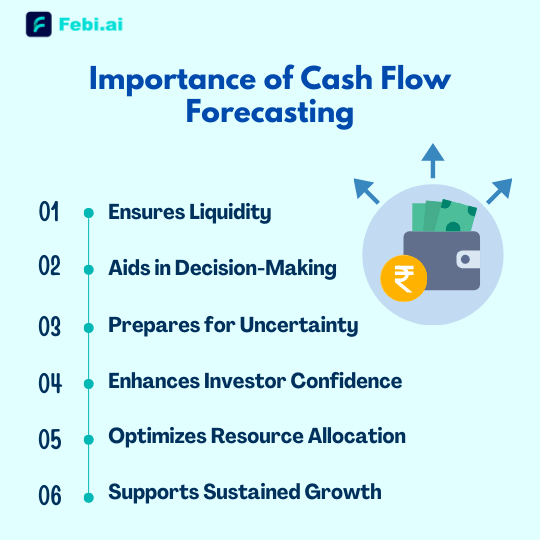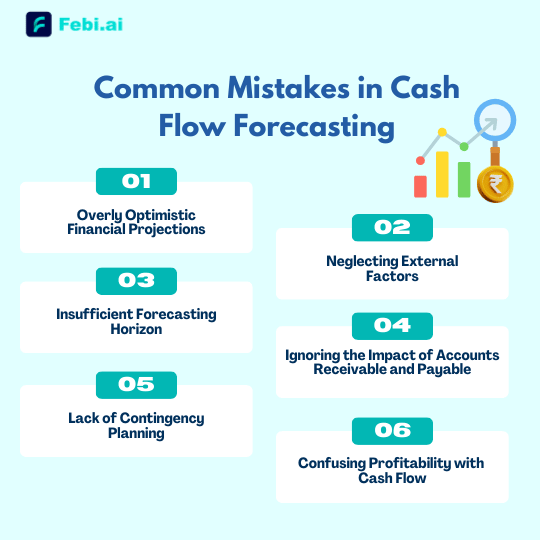Imagine navigating your startup’s financial future with the precision of a seasoned sailor charting unknown waters. Cash flow forecasting is your compass, guiding you through the ebbs and flows of your business’s finances. In the unpredictable sea of entrepreneurship, having a robust cash flow forecast can make a huge difference between smooth sailing and capsizing. Continue reading to understand the intricacies of cash flow forecasting and equip your startup during business planning and after, with the tools to steer towards financial growth.
Table of Contents
What is Cash Flow Forecasting?
Cash flow forecasting is the process of estimating the amount of money expected to flow in and out of your business over a specific period. This projection includes all sources of cash inflows such as sales revenue, loans, and investments, as well as cash outflows like operating expenses, salaries, and loan repayments. Essentially, it’s a financial roadmap that helps businesses anticipate future cash positions, ensuring they have sufficient liquidity to meet obligations and seize opportunities.
Importance of Cash Flow Forecasting

For startups, cash flow forecasting is more than just a financial exercise; it’s a lifeline. Here’s why it’s crucial:
- Ensures Liquidity: Accurate cash flow forecasting ensures your business can cover its expenses without scrambling for funds.
- Aids in Decision-Making: Knowing your future cash position allows you to make informed decisions during budgeting and otherwise, about investments, expansions, or cost-cutting measures.
- Prepares for Uncertainty: By predicting potential shortfalls, you can plan for contingencies and avoid unexpected financial crises.
- Enhances Investor Confidence: Investors seek assurance that their capital will be managed prudently. A solid cash flow forecast demonstrates financial responsibility and strategic planning.
- Optimizes Resource Allocation: By understanding your cash flow, you can allocate resources effectively, maximizing your return on investment and minimizing unnecessary expenses.
- Supports Sustained Growth: Cash flow forecasting provides the foundation for sustainable growth by identifying funding needs, evaluating expansion opportunities, and making strategic financial plans.
Areas Where Businesses Use Cash Flow Forecasting
Cash flow forecasting is a versatile tool used in various areas of business:
- Operational Planning: Ensures that day-to-day operations run smoothly without financial hiccups.
- Investment Planning: Helps in evaluating the viability and timing of new investments or projects.
- Debt Management: Assists in planning for loan repayments and managing debt effectively.
- Strategic Growth: Supports long-term business planning and growth strategies by providing a clear financial picture.
Common Mistakes in Cash Flow Forecasting
Cash flow forecasting is a critical component of financial planning and forecasting, yet it’s an area where many businesses, regardless of size, make crucial errors. Here are some common mistakes to avoid:

1. Overly Optimistic Financial Projections
One of the most frequent missteps is assuming overly positive financial scenarios. Inflated revenue estimates and underestimated expenses can lead to a false sense of financial security. It’s essential to maintain a realistic outlook and base projections on historical data, market trends, and conservative estimates.
2. Neglecting External Factors
A comprehensive cash flow forecast considers the broader economic environment. Ignoring market fluctuations, economic downturns, industry trends, and even seasonal variations can significantly impact cash flow. Incorporating these external factors into your projections is vital for accurate financial forecasting.
3. Insufficient Forecasting Horizon
Creating a short-term cash flow forecast might seem sufficient, but a longer-term perspective is essential for strategic planning. By looking ahead several months or even years, businesses can anticipate potential cash flow challenges and opportunities. A rolling forecast, updated regularly, provides a dynamic view of the financial industry.
4. Ignoring the Impact of Accounts Receivable and Payable
Effective cash flow management hinges on understanding the timing of both incoming and outgoing payments. Overlooking the impact of accounts receivable (money owed by customers) and accounts payable (money owed to suppliers) can distort cash flow projections. Implementing robust credit policies and efficient payment processes is crucial.
5. Lack of Contingency Planning
Unexpected expenses, economic downturns, or supply chain disruptions can severely impact cash flow. Building a contingency fund and incorporating potential risks into the forecast is essential for business resilience. Sensitivity analysis can help assess the impact of different scenarios on cash flow.
6. Confusing Profitability with Cash Flow
While profitability is important, it doesn’t equate to cash flow. Profit is an accounting measure, while cash flow reflects the actual movement of money in and out of the business. Understanding the difference and focusing on cash flow is crucial for financial stability.
By recognizing these common pitfalls and implementing effective strategies, businesses can significantly improve the accuracy of their cash flow forecasts and make informed financial decisions.
Step-by-Step Guide for Cash Flow Forecasting
Ready to create a cash flow forecast for your startup? Follow these steps for a seamless cash flow management:

- Identify Cash Inflows: List all potential sources of income, including sales revenue, investment income, and any loans or grants.
- Determine Cash Outflows: Identify all expenses such as rent, salaries, utilities, supplies, and loan repayments.
- Set a Time Frame: Choose a financial forecasting period (weekly, monthly, quarterly) that aligns with your business needs.
- Create a Cash Flow Statement: Use the identified inflows and outflows to create or refer to a cash flow statement. This document should detail expected cash movements over the chosen period.
- Analyze and Adjust: Compare your forecast against actual cash flow regularly. Analyze variances and adjust your financial forecasting as needed.
- Plan for Contingencies: Build a buffer for unexpected expenses or income shortfalls. This can include setting aside a portion of funds as a safety net.
- Use Technology: Utilize financial forecasting software to automate calculations and enhance accuracy. Many tools offer features like scenario analysis and real-time updates.
Conclusion
Ultimately, a robust cash flow forecast is a cornerstone of financial stability, business planning and growth. By proactively managing cash flow, startups can optimize resource allocation, secure funding, and build resilience. With the right tools and mindset, it’s possible to transform cash flow forecasting from a daunting task into a strategic advantage that propels your business forward.
Ready to see Febi.ai in action and discover how it can revolutionize your cash flow management? Book a free demo today and let our experts guide you through the platform’s features and benefits. We offer a live demo as per your specific needs and help you understand how Febi.ai can empower your startup to achieve financial success.
Book a demo today. Your financial future starts here.










